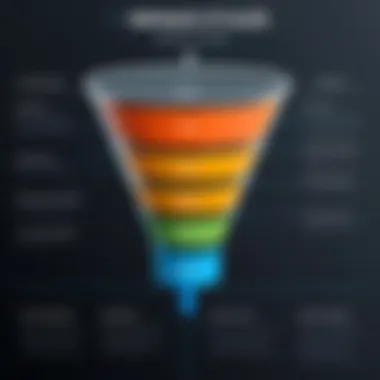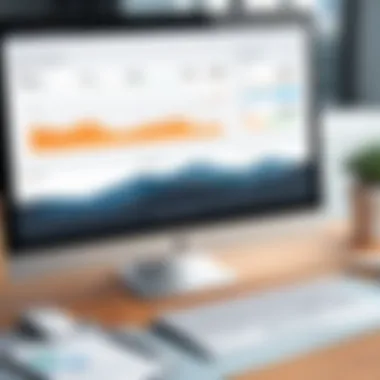Understanding the SaaS Sales Funnel: A Comprehensive Guide


Intro
In software-as-a-service industries, sales determine the progression from potential customers to loyal clients. Understanding the sales funnel offers vital insights for any company aiming to enhance their market presence. The sales funnel encapsulates the customer’s journey and helps in mapping key interactions that foster meaningful relationships.
This guide specifically examines the SaaS landscape, dissecting its unique segments from initial awareness through to retention. By scrutinizing how each phase influences buyer behavior, we will identify the most successful sales strategies.
A common misconception is that the sale ends after the purchase is made. Rather, the real work lies in nurturing and supporting the customer throughout their journey. Not only does this maximizes customer lifetime value, it also opens pathways for upsells and cross-sells that are crucial in SaaS sales.
This guide promises to furnish both veterans and newcomers with tools to finesse their sales techniques and expand their customer base efficiently. In diving deeper into these intricacies, we aim to reveal actionable strategies that will pay dividends in terms of both conversion rates and customer satisfaction.
App Overview
Although we are discussing the SaaS sales funnel, it is important to recognize the role of applications in this environment. Business applications mainly serve as the platforms through which customers interact with services. Introducing a SaaS product may commonly include its core functionalities, features, and overall relevance to the industry.
Main features like secure cloud storage, customizable interfaces, or collaboration tools further buyer engagement. Recognizing how these aspects align with user needs accentuates the connection between SaaS sales strategies and application design.
Key functionalities of a SaaS product typically include:
- Real-time analytics
- Seamless integration with other tools
- Focused user experience"
Understanding these facets paints a clearer picture of not just selling software, but also understanding what clients genuinely require from their services.
To summarize, we will next outline the important stages of the SaaS sales funnel and emphasize effective techniques to optimize each phase. With tools and strategies in-store for different complexities encountered, preparing for any challenges ahead increases success probability.
Prelims to SaaS Sales Funnel
The SaaS sales funnel acts as a guiding framework for understanding users' journey from realizing a problem to selecting a solution. Each phase of this funnel embodies critical moments for both potential clients and developers. The way a user navigates the funnel influences not just initial sales but also long-term customer relationships. In the realm of software-as-a-service, a clear grasp of this funnel helps in aligning marketing efforts with actual client needs, ultimately optimizing conversion rates.
Defining the SaaS Sales Funnel
To understand the SaaS sales funnel, it is essential to explore its definition. This funnel is a visual representation of the stages that a prospect goes through before becoming a paying customer and remaining a loyal user. It starts from the awareness stage, where potential users first learn about a product, and ends with customer retention. Each stage signifies different interactions that necessitate targeted strategies, thus aiding businesses to efficiently guide prospects along this pathway.
Importance of the Sales Funnel in SaaS
Recognizing the importance of the sales funnel in SaaS operations is vital for any tech-centric business aiming for growth.
- Framework for Analysis: The sales funnel offers a structured way to analyze where prospects are falling off during the journey towards purchase. This analytic is essential for optimizing strategies.
- Targeted Marketing Efforts: With an understanding of the funnel’s complexity, businesses can more effectively tailor their marketing approaches to align with needs and motives specific to each stage.
- Focus on Customer Retention: The funnel emphasizes the need for not just attracting new customers, but also retaining existing ones, signifying the recurring revenue nature of SaaS products.
Stages of the SaaS Sales Funnel
The stages of the SaaS sales funnel are essential in orchestrating a pathway from initial engagement to successful customer retention. By clearly delineating these stages, businesses gain insight into buyer behaviors and preferences, improving sales strategies over time. Each stage serves as a yardstick measuring customer readiness, helping companies allocate resources efficiently and tailor their approach to meet varying needs. For those in the SaaS industry, embracing this funnel structure is not just a best practice—it’s fundamental for sustainable growth.
Awareness Stage
In the awareness stage, potential customers recognize a problem that your SaaS solution can solve. It involves triggering curiosity and educating your target audience about your offerings. At this point, the goal is not to sell, but to generate initial interest. Techniques such as targeted digital advertising, informative blogs, or thought leadership content are crucial. This stage often includes:*
- High-visibility content that answers foundational questions driven by your target audience.
- Search engine optimization strategies that place your content directly in front of potential leads.
Such focused efforts enhance visibility, opening doors for prospects curious about solving specific challenges.
Interest Stage
Once awareness is established, leads transition to the interest stage, typically characterized by increased engagement with content related to your SaaS tool. Here, marketers must cultivate deeper connections. This stage is about showcasing value through targeted information. Look towards methods such as:
- Offering webinars or demos to demonstrate the product's utility.
- Engaging leads through tailored email campaigns highlighting case studies.
Each interaction serves to deepen the lead's interest, boosting the likelihood of conversion as potential customers begin to visualize the benefits of integration.
Consideration Stage
The consideration stage is where potential customers weigh their options, comparing your software against competing solutions. They delve into intricacies that demonstrate how your offer stands out in practical terms.
Providing high-quality content, such as:


- Detailed case studies that showcase real-world implementation, and
- Comprehensive product comparisons, delivers the evidence leading to informed decisions. Encouraging trials or evaluations also empowers prospects to explore before fully committing.
Decision Stage
In the decision stage, your prospects sit at the doorstep of making a buying decision. Here, sales teams should offer tailored solutions and follow-up discussions about pricing and offerings. Highlighting limited-time offers could sway a prospect feeling uncertain. Strategies include:
- Conducting consultations to tailor solutions specifically to the client’s needs.
- Facilitating testimonials and case studies annually to affirm the software's value.
Conversations should center on resolving any final reservations, solidifying the value proposition to nudge prospects toward conversion.
Retention Stage
The retention stage often receives less attention, but is built upon the foundation of experience post-purchase. Happy customers equipped with valuable insights hold the key to upside in recurring revenue streams—reducing churn while enhancing customer loyalty. The focus is on keeping the customer engaged and fulfilled:
- Implement feedback loops to empower customers to voice their concerns.
- Create educational resources dominated by webinars and training videos.
These strategies enhance user experience and customer lifetime value while rewarding loyalty and interaction.
In summary, successfully navigating each stage of the SaaS sales funnel is critical for generating leads, driving conversions, and ensuring long-term customer satisfaction and retention.
Key Strategies for Each Funnel Stage
Understanding the key strategies employed at each stage of the SaaS sales funnel is vital for ensuring that prospects convert to loyal customers. Each phase presents unique challenges and opportunities that require tailored approaches. Marketers and sales teams must recognize the distinct necessities of each funnel stage for effective communication with prospects. Strategies used here must not only address customer needs but should also align with overall business goals.
Strategies for the Awareness Stage
At the awareness stage, the primary focus is to make potential customers conscious of your product and brand. It is essential to cast a wide net to reach an audience that fits your target demographic. Here are some practical strategies:
- Content Marketing: Publishing informative blogs, podcasts, and videos can help explain the problems your product solves.
- Search Engine Optimization (SEO): Optimizing your content with keywords can increase visibility in search results, driving more traffic to your website.
- Social Media Outreach: Platforms like Facebook, Twitter, and LinkedIn are effective for promoting your content and reaching potential users.
- Paid Advertising: Utilize pay-per-click campaigns to gain more traction and visibility quickly.
Employ regular analysis of your outreach performance to ensure the strategies you implement resonate well with your target audience.
Engagement Tactics for the Interest Stage
Once awareness is established, the next step is to engage those showing interest. Use various tactics to deepen their curiosity and personalize interactions.
- Email Campaigns: Send targeted emails that provide value and showcase benefits your solution offers to maintain interaction with leads.
- Webinars and Live Demos: Hosting informative sessions can effectively illustrate scenarios where your product excels.
- Retargeting Ads: Show ads to users who have interacted with your content previously, reminding them of the value you provide.
- Surveys and Feedback Loops: Request feedback to understand user preferences and provide content they explicitly desire.
These engagement tools not only enrich user experience but create a foundation of trust that will prove essential in the later stages.
Nurturing Prospects in the Consideration Stage
In the consideration stage, prospects evaluate their options, and it is pivotal to nurture them through this process. You must consistently deliver information that aligns with their needs and concerns.
- Case Studies and Success Stories: Sharing real-world testimonials displaying success leverage credibility and illustrate practical applications.
- Comparison Guides: Provide clear information contrasting your software against competitors, focusing on unique features and added value.
- Free Trials and Freemiums: Allowing potential customers to experience your product first-hand can help alleviate hesitation about making a purchase.
- Personalized Recommendations: Using data from earlier interactions can aid sales teams in creating tailored conversations that resonate with prospects, improving their journey.
Showing continued support here encourages prospects to lean towards making a decision in your favor.
Closing the Sale in the Decision Stage
The decision stage is where all the efforts toward marketing and guidance pivot towards converting leads into customers.
- Clear Call-to-Action (CTA): Ensure product offerings and next steps are decisively stated to urge customers to take the final step.
- Trust Signals: Present testimonials, rating metrics, and IP protection promises to eliminate barriers for prospects.
- Address Objections Directly: Know common objections and inquire if they’re feeling any of them, optimally responding with refutations backed by strong data.
- Limited Time Offers: Capacitate urgency through discounts or exclusive incentives for quick decisions.
This phase requires a systematic closure strategy to harness the leading efforts into a successful sale.
Enhancing Customer Loyalty in the Retention Stage
Finally, maintaining a customer after the sale is as crucial as making the sale. Strategies here can significantly impact long-term success.
- Onboarding Experience: Carefully introduce new users to your product through user guides and personal assistance to enhance understanding and usability.
- Regular Check-Ins: Engaging customers post-purchase through newsletters or calls to ensure satisfaction keeps them connected.
- Loyalty Programs: Implement rewards for referrals or continued use, fostering loyalty among existing users.
- Feedback Mechanisms: Maintain a structured method to receive input, which helps identify weaknesses. Act on this feedback to continuously improve your service.
Customer retention is about quality interactions beyond the sale, ensuring users find continual value in your service.


Common Challenges in the SaaS Sales Funnel
In the SaaS industry, managing the sales funnel is essential for converting leads into loyal customers. However, multiple challenges can hinder the effectiveness of this funnel. Recognizing and addressing these challenges can lead to improved sales processes and higher retention rates. The insights provided in this Section aim to empower professionals in the SaaS market.
Lead Generation Issues
One of the most critical challenges within the SaaS sales funnel is creating a steady stream of quality leads. Many companies struggle with inconsistent lead generation. Multiple factors contribute to this, including ambiguous targeting and lack of an effective marketing strategy.
Improper targeting can often lead to wasted resources in outreach efforts. Here are some relevant aspects to consider:
- Identify your ideal customer profile.
- Utilize various marketing channels to reach prospective customers.
- Test different lead-generation tactics to see what resonates best with your target audience.
Additionally, depending solely on one method, like social media or email marketing, can limit your reach. Exploring multiple avenues provides broader visibility, increasing the potential lead pool.
Managing Customer Expectations
Another significant challenge in the SaaS sales funnel is managing customer expectations. As prospects move down the funnel, their expectations often evolve based on interactions with marketing materials and sales representatives.
Clear communication during the customer's journey is vital in preventing misalignment:
- Be transparent about product features and limitations.
- Set realistic timelines for onboarding and integration.
- Clearly outline pricing structures to avoid confusion.
Exceeding customer expectations can foster loyalty and drastically improve retention rates. Customers are more likely to become long-term users. For this reason, organizations must invest in customer relationship management to facilitate meaningful interactions.
Continuous engagement and clarity is key. Meeting, or exceeding, what clients expect can be pivotal.
By addressing the issue of lead generation and managing customer expectations effectively, the SaaS sales funnel can convert prospects into sustainable, loyal customers. Acknowledgment of these challenges creates a roadmap for improvement, allowing for ongoing success in a competitive market.
Tools and Technologies to Optimize the SaaS Sales Funnel
The sales funnel in the Software as a Service (SaaS) industry is a complex structure. To navigate this structure efficiently, the right tools and technologies can play a crucial role. These technologies can help streamline processes, improve lead management, enhance customer interactions, and ultimately drive higher conversion rates.
Understanding the importance of optimizing the SaaS sales funnel is vital because it directly affects customer acquisition and retention. Tools enhance visibility into customer behavior. This can aid organizations in tailoring their strategies effectively to meet customer needs.
CRM Software for Tracking Leads
CRM software functions as the backbone of many SaaS sales processes. This systematic tool helps teams manage relationships and interactions with prospective and current customers.
Some key features of CRM software include:
- Lead management: It allows tracking leads throughout the funnel, giving insight into where chances of conversion might exist.
- Segmenting customers: This enables targeted communication strategies based on specific customer data.
- Automating follow-ups: Efficient follow-up on leads ensures no potential customer falls through the cracks.
Several popular CRM solutions exist, like Salesforce, HubSpot, or Zoho, which come equipped with analytical capabilities allowing businesses to assess lead performance and optimize actions focused on growth.
Considerations when selecting a CRM
Choosing the right CRM system can impact funnel effectiveness significantly.
- Compatibility: Ensure it integrates smoothly with existing tools.
- Scalability: The CRM should how easily it can expand with company growth.
- Usability: A complex CRM might hinder staff adoption.
Analytics Tools for Performance Measurement
Analytics tools offer a wealth of insights essential for measuring performance in the SaaS sales funnel. Tracking metrics can reveal trends, user behavior, and areas demanding improvement.
Key features of effective analytics tools include:
- Dashboard metrics: Visual representations help decision-makers quickly assess various areas of the sales funnel.
- Real-time data tracking: This ensures that adjustments can be made promptly to strategy relating to effectiveness in closing sales.
- User engagement analysis: Understanding how users interact with the product or service provides qualitative data that complements quantitative measures.
Common analytics platforms like Google Analytics or Mixpanel can help you tailor your product and marketing strategies by understanding user actions. Utilizing insightful data empowers businesses to enhance overall sales performance in their SaaS funnel.
The proper tools enhance clarity and efficiency in managing the sales funnel, resulting in better optimized strategies that meet customer needs and streamline processes for greater success.
Best Practices for SaaS Sales Funnel Optimization


Optimizing the SaaS sales funnel is essential,不丧失 any opportunity. Best practices can structure efforts and drive results effectively. This section focuses on methodologies to enhance performance at each phase of the sales funnel.
Continuous Testing and Iteration
Continuous testing is the backbone of successful SaaS sales funnel optimization. Software develops quickly; strategy must match pace. Organizations should focus on A/B testing, analyzing bounce rates, and conversion metrics. Each test provides data that refines marketing efforts and consumer engagements.
Start by defining specific goals, whether increasing click-through rates or enhancing email open rates. A/B testing different landing pages оr email formats to see what resonates better provides actionable insights. By continuously improving tactics, businesses can adapt to dynamic market scenarios. Adaptations may seem minor but consistently bring substantial impacts over time.
Case Studies of Successful SaaS Sales Funnel Implementation
Understanding case studies of successful SaaS sales funnel implementation provides essential insights into effective strategies and practices. Real-life examples illustrate how different companies navigate the complexities of the SaaS landscape, offering valuable lessons for newcomers and experienced players alike. Analyzing these case studies sheds light on specific elements that contribute to success, allowing organizations to adopt best practices while avoiding common pitfalls.
Case studies reveal a range of benefits. They show the applicability of the sales funnel model in various contexts and demonstrate tangible results achieved through specific tactics. This analysis offers actionable takeaways that can be adapted to any SaaS business model. Deep dives into startup success stories and established companies showcase the diverse approaches and innovations possible across the industry.
Moreover, these case studies highlight key considerations that companies might overlook:
- Tailoring the funnel to target audience
- Continuous testing and optimization of strategies
- Utilizing the right tools and metrics for performance measurement
Through exploration of these scenarios, companies can build a stronger framework for their sales efforts, driving both acquisition and retention while minimizing wasted resources.
Startup Success Stories
Startups often operate under resource constraints, making successful implementation of their sales funnel even more crucial. A prime example of startup success is Slack. Initially launched as an internal communication tool, Slack's team focused on harnessing user feedback during its early phases to define their target market effectively.
Key strategies Slack implemented in their sales funnel included:
- Freemium model: Allowing potential customers to explore core features without immediate pressure, making it easier for the service to gain traction.
- Product-Market Fit: Continuous refinement based on user input turned initial users into brand advocates.
- Word-of-Mouth: Satisfied users helped grow their presence organically.
These strategies proved instrumental in seamlessly navigating Slack’s awareness and interest stages. Their evolution led to SLack becoming an industry frontrunner, demonstrating the potential for startups leveraging a well-planned sales funnel.
Established Companies and Their Approaches
Established companies also demonstrate smart use of the SaaS sales funnel to enhance operations. A notable instance is Adobe. Transiting from traditional licensing to a cloud-based subscription model, Adobe revamped its entire sales approach.
To ease customers into their new SaaS format, Adobe engaged effectively with loyal users through comprehensive feedback methods.
Its approaches included:
- Enhanced Customer Engagement: Utilizing automatic renewals to retain current customers, positively impacting customer’s lifetime value.
- Sophisticated User-Centric Marketing: Carefully tailored messaging to align user expectations influenced customer decision-making.
- Integrated Offering: Providing bundles of their popular creative cloud services simplified lower value opt-ins increasing upsell chances.
Case studies like those of Slack and Adobe jconceptualize how these companies strive to optimize and refine their sales funnels. Each offers practical solutions on aligning marketing, user acquisition, and retention efforts for better results.
These insights overall underscore the importance of evaluating existing implementations and continuous improvement based on real-world data and experiences. Effective SaaS companies leverage a precise understanding of the funnel to engage potential clients better and maintain long-lasting relationships with existing customers.
End and Future Trends in SaaS Sales Funnels
Understanding the conclusion and future trends in the SaaS sales funnel is essential to key stakeholders. These insights not only underscore the importance of adaptability but also highlight opportunities for growth and consolidation in the competitive landscape. The SaaS industry is ever-evolving, and recognizing changing dynamics is vital.
Shifts in Customer Behavior
Customer behavior is experiencing significant shifts that directly impact the SaaS sales funnels. Users now have access to an abundance of information. They often rely on online reviews, peer recommendations, and extensive product research before making a purchasing decision. In this digital age, the information age, potential customers demand a personalized approach.
Benefits of Understanding Customer Shifts:
- Improved targeting through more relevant marketing efforts.
- Enhanced customer satisfaction due to responsive tactics.
- Increased retention as a result of tailoring customer experience.
Clients are addressing pain points earlier, making initial engagement most vital. SaaS retailers must adopt a proactive strategy that reflects these behaviors while aligning perfectly with service offerings. This necessitates precise data analytical skills and emotional intelligence in marketing efforts.
Emerging Technologies Impacting SaaS Sales
The intersection of technology and customer experience is notable in current SaaS trends. New solutions allow for greater efficiency and personalization in the sales funnel. Automation, for instance, eases the outreach processes while remaining highly effective.
Key Technologies to Monitor:
- AI and Machine Learning: Enhance customer insights to provide personalized experiences tailored to individual needs.
- Chatbots and Virtual Assistants: Enable real-time interaction with prospects, which fosters engagement before they enter deeper stages of consideration.
- Big Data Analytics: Allow organizations to recognize patterns and process a high volume of information from potential customers.
By implementing these technologies, SaaS companies can significantly sharpen their tactics. This readiness to adjust ensures greater relevance in the chaotic marketplace and creates a more fortified position against competitors.
Investing in technology is not just beneficial; it is often a necessity to maintain relevance in a fast-paced environment.







